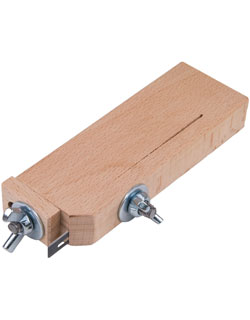Update: January 10th, 2018. Unfortunately, The Thomas Company is no longer making the lace cutter. We hope to find a new manufacturer soon. Or, if you or a friend are handy with carpentry and would enjoy making 25 or so of these at a time please contact us at: catalog at davidmorgan.com or give us a call at: (800) 234-4934.
When we sold our last lace cutter several months ago, we discovered many people still wanted to purchase one. We found The Thomas Company, a local Seattle company, to make a new lace cutter based on the old specs.
This leather tool is a favorite of magician and whipmaker Louie Foxx. Louie has told us he’s tried a lot of the other lace cutters and prefers this one for comfort and durability.
Made of beechwood, it holds an injector blade that adjusts the lace width from under 1/8 inch up to about 1/2 inch. Two razor blades are included with each cutter.
Although the lace cutter is adjustable, we find it easiest to use multiple cutters set to each width we routinely need. For more information on using the lace cutter, please see David Morgan’s book Braiding Fine Leather.
LEARN MORE ABOUT:
